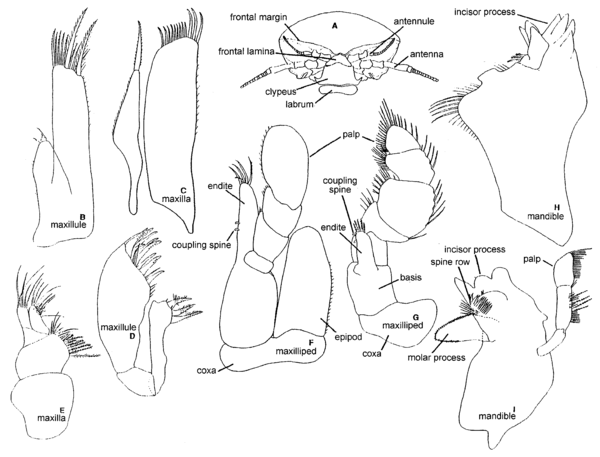- incisor process
-
Cutting process on mandible; widely separated from molar or grinding process in some shrimps, e.g., Pandalidae, in close proximity in others, e.g., Oplophoridae [Butler, T.H.].Cutting process, often toothed or cusped, of the mandible [Perez Farfante and Kensley, 1997].Cutting surface (lobe) of mandible (as opposed to molar or grinding lobe) (see Fig. 23h) [Hobbs and Jass, 1988].The cutting (as opposed to the molar or grinding) lobe of the mandible [Hobbs, Hobbs, and Daniel 1977].The distal biting part of the mandible that typically bears one or more cusps. On its medial side, it bears the spine row [Wilson, 1989].The fixed distal 'cutting blade' of the mandible [Holdich and Jones, 1983].(Class Cephalocarida):Food-gripping process (vs. grinding = molar process) at end of each mandible) Extends into atrium oris under labrum. Variously armed with spines, setae, and denticles [Stachowitsch, 1992].(Order Cumacea):Distal gripping process (vs. grinding = molar process) of each mandible. (Syn. pars incisiva) [Stachowitsch, 1992].(Order Tanaidacea):Distal gripping process (vs. grinding = molar process) of each mandible [Stachowitsch, 1992].(Order Decapoda):Food-gripping process (vs. grinding = molar process) of each mandible. May be fused with molar process. (Syn. pars incisiva) [Stachowitsch, 1992].(Order Amphipoda):Gripping process (vs. grinding = molar process) of each mandible [Stachowitsch, 1992].(Order Isopoda):Distal, often toothed gripping process (vs. grinding = molar process) of each mandible [Stachowitsch, 1992].(Order Isopoda):Grasping, piercing or slicing structure arising apically on body of mandible [Wetzer et al. 1997].(
 )Nomenclature of isopod cephalon (A). Examples of isopod mouth appendages: Idoteidae (B, C, F, H); Cirolanidae (D, E, G, I). [Wetzer et al. 1997](Order Mysida):Distal gripping process (vs. grinding = molar process) of each mandible [Stachowitsch, 1992].(Order Stomatopoda):Well-developed food-gripping (vs. grinding = molar process) of each mandible; bears single row of teeth and lies over labrum. (Syn. pars incisiva) [Stachowitsch, 1992].(Order Leptostraca):Gripping process (vs. grinding = molar process) of each mandible. (simple, with teeth) [Stachowitsch, 1992].(Class Remipedia):Cutting process (vs. grinding = molar process) at tip of each mandible; incisor processes of left and right mandibles are generally asymmetrical, i.e., number (three or four) and shape of large denticles differ [Stachowitsch, 1992].(Superorder Syncarida):Distal gripping process (vs. proximal grinding = molar process) of each mandible [Stachowitsch, 1992].(Order Thermosbaenacea):Distal gripping process (vs. grinding = molar process) of each mandible [Stachowitsch, 1992].(Order Euphausiacea):Gripping process (vs. grinding = molar process) of each mandible [Stachowitsch, 1992].
)Nomenclature of isopod cephalon (A). Examples of isopod mouth appendages: Idoteidae (B, C, F, H); Cirolanidae (D, E, G, I). [Wetzer et al. 1997](Order Mysida):Distal gripping process (vs. grinding = molar process) of each mandible [Stachowitsch, 1992].(Order Stomatopoda):Well-developed food-gripping (vs. grinding = molar process) of each mandible; bears single row of teeth and lies over labrum. (Syn. pars incisiva) [Stachowitsch, 1992].(Order Leptostraca):Gripping process (vs. grinding = molar process) of each mandible. (simple, with teeth) [Stachowitsch, 1992].(Class Remipedia):Cutting process (vs. grinding = molar process) at tip of each mandible; incisor processes of left and right mandibles are generally asymmetrical, i.e., number (three or four) and shape of large denticles differ [Stachowitsch, 1992].(Superorder Syncarida):Distal gripping process (vs. proximal grinding = molar process) of each mandible [Stachowitsch, 1992].(Order Thermosbaenacea):Distal gripping process (vs. grinding = molar process) of each mandible [Stachowitsch, 1992].(Order Euphausiacea):Gripping process (vs. grinding = molar process) of each mandible [Stachowitsch, 1992].
Crustacea glossary. Natural History Museum of Los Angeles County. 2011.
